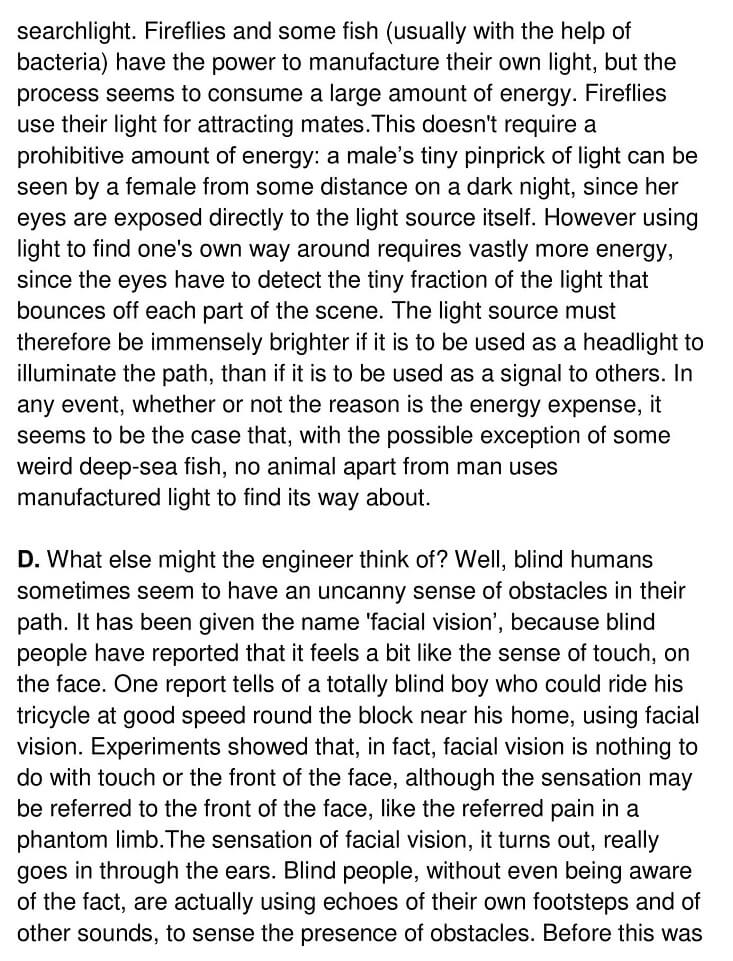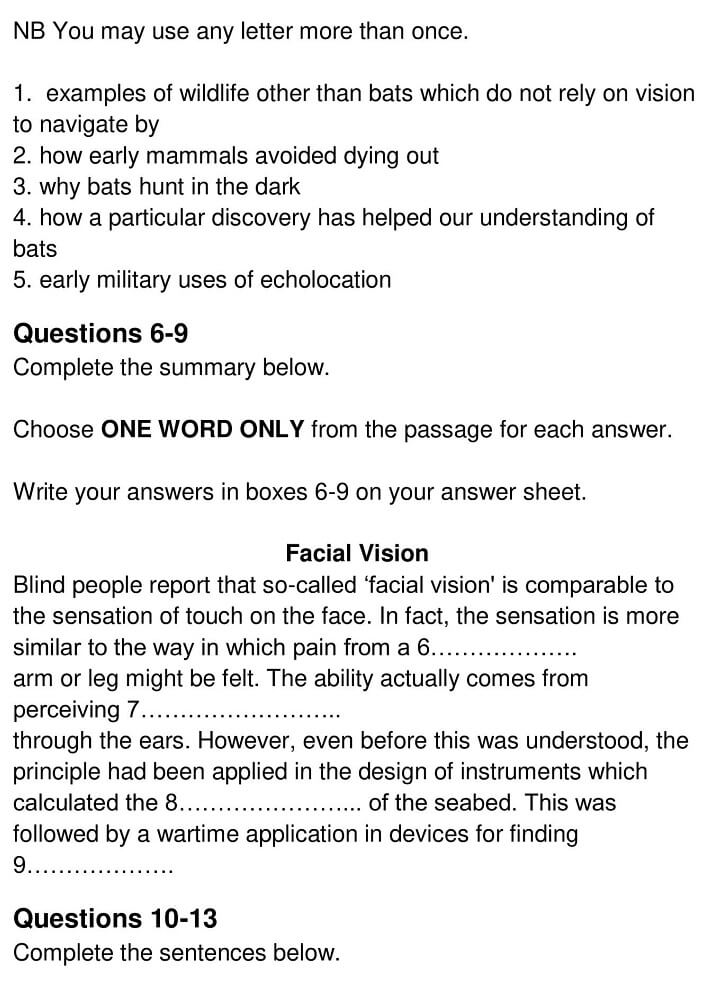Let’s Go Bats – IELTS Reading Answers
5 min read
Updated On
-
Copy link
Table of Contents

Limited-Time Offer : Access a FREE 10-Day IELTS Study Plan!
The Academic passage ‘Let’s Go Bats’ is a reading passage that appeared in an IELTS Test.
It contains some of the IELTS reading question types. If you are interested in familiarising yourself with all the question types, don’t hesitate to take an IELTS reading practice test.
Let’s Go Bats





Answers
| Question number | Answer | Explanation |
|---|---|---|
| 1 | B | In paragraph B, the writer discussed that ‘bats have an engineering problem’: how to ‘find their way and find their prey in the absence of light’. Bats ‘are not the only creatures to face this difficulty’. ‘Deep-sea fish and whales’ have little or no light by day or by night. ‘Fish and dolphins that live in extremely muddy water’ cannot see because, although there is light, it is obstructed and scattered by the dirt in the water.
Hence, the answer is B. |
| 2 | A | Paragraph A points out the fact that ‘in the time when the dinosaurs’ dominated the daytime economy, ‘our mammalian ancestors probably only managed to survive’ because ‘they found ways of scraping a living at night’. Only ‘after the mysterious mass extinction of the dinosaurs’ about 65 million years ago were ‘our ancestors able to emerge into the daylight in any substantial numbers’. Hence, the answer is A. |
| 3 | A | Paragraph A mentions that bats ‘hunt at night’, and cannot use light to help them find prey and avoid obstacles. As ‘there is a living to be made at night’, and given that ‘alternative daytime trades are thoroughly occupied’, ‘natural selection has favored bats that make a go of the night-hunting trade’. Hence, the answer is A. |
Unlock All Answers
| 4 | E | Paragraph E states that the ‘underlying mathematical theories of radar and sonar are very similar’, and much of our scientific understanding of the details of ‘what bats are doing has come from applying radar theory to them’. The ‘American zoologist Donald Griffin’ was largely responsible for the ‘discovery of sonar in bats’. Hence, the answer is E. |
| 5 | D | Paragraph D explains the sensation of facial vision goes in through the ears. Blind people are actually using echoes of their own footsteps and of other sounds, to sense the presence of obstacles. After this technique had been invented, it was only a matter of time before ‘weapons designers adapted it for the detection of submarines’. Both sides in the ‘Second World War relied heavily on these devices’, under such code names as ‘Asdic (British) and Sonar (American), as well as Radar (American) or RDF (British)’, which ‘uses radio echoes rather than sound echoes’.
Hence, the answer is D. |
| 6 | phantom | Paragraph D finds that experiments showed that ‘facial vision’ has nothing to do with touch or the front of the face, although the ‘sensation may be referred to’ (more similar to) ‘the front of the face’, ‘like’ (comparison) ‘the referred pain in a phantom limb’. Hence, the answer is ‘phantom’. |
| 7 | echoes/obstacles | Paragraph D points out that the ‘sensation of facial vision’ really goes in ‘through the ears’. ‘Blind people’ actually uses ‘echoes’ of their own footsteps and of other sounds, to ‘sense the presence of obstacles’ (perceiving troubles). Hence, the answer is ‘echoes/obstacles’. |
| 8 | depth | Paragraph D notes that ‘the sensation of facial vision goes in through the ears’. Before this was discovered, ‘engineers’ had already ‘built instruments’ (applied in the design of instruments) to exploit the principle to ‘measure’ (calculate) the ‘depth’ of the ‘sea under a ship’ (seabed). Hence, the answer is ‘depth’. |
| 9 | submarines | Paragraph D states that the ‘sensation of facial vision’ goes in through the ears. Before this was discovered, engineers had already built instruments to ‘exploit the principle to measure the depth of the sea under a ship’. After this technique had been invented, ‘weapons designers adapted’ (wartime application) the principle ‘for the detection’ (finding) ‘of submarines’. Hence, the answer is ‘submarines’. |
| 10 | natural selection | Paragraph E mentions that the ‘Sonar and Radar pioneers didn’t know’ (before invention of radar), but ‘bats’, or ‘natural selection working on bats’, had perfected the system ‘tens of millions of years earlier’; and their ‘radar achieves feats of detection and navigation’. Hence, the answer is ‘natural selection’. |
| 11 | radio waves | Paragraph E says that it is ‘technically incorrect’ (inaccurate term) to talk ‘about bat ‘radar’’, ‘since’ (because) ‘they do not use radio waves’ (in their navigation). Hence, the answer is ‘radio waves’. |
| 12 | mathematical theories | Paragraph E points out that it is technically
incorrect to talk about bat ‘radar’, since they do not use radio waves. It is sonar. But the underlying ‘mathematical theories of radar and sonar are very similar’. Hence, the answer is ‘mathematical theories’. |
| 13 | zoologist | Paragraph E informs that the ‘American zoologist Donald Griffin’, who was largely responsible for the discovery of sonar in bats, ‘coined the term ‘echolocation’’ (first used the term ‘echolocation) to cover both sonar and radar, whether used by animals or by human instruments. Hence, the answer is ‘zoologist’. |
Check More IELTS Reading Answers
Also check :
Practice IELTS Reading based on question types

Start Preparing for IELTS: Get Your 10-Day Study Plan Today!
Recent Articles

Nehasri Ravishenbagam

Haniya Yashfeen

Haniya Yashfeen

Haniya Yashfeen




Post your Comments